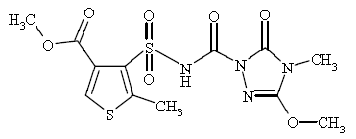|
thiencarbazone-methyl
Refer to: http://www.epa.gov/pesticides/chem_search/reg_actions/registration/fs_PC-015804_30-Oct-08.pdf
Status: modified ISO 1750 (published)
IUPAC: methyl 4-[(4,5-dihydro-3-methoxy-4-methyl-5-oxo-1H-1,2,4-triazol-1-yl)carbonylsulfamoyl]-5-methylthiophene-3-carboxylate
CAS: methyl 4-[[[(4,5-dihydro-3-methoxy-4-methyl-5-oxo-1H-1,2,4-triazol-1-yl)carbonyl]amino]sulfonyl]-5-methyl-3-thiophenecarboxylate
Reg. No.: 317815-83-1
Formula: C12H14N4O7S2
Activity: herbicides (triazolone herbicides)
Notes: This substance is a derivative of thiencarbazone [936331-72-5].
Structure:

Pronunciation: thī-ěn-karb-a-zōn mē-thīl Guide to British pronunciation
InChIKey: XSKZXGDFSCCXQX-UHFFFAOYSA-N
InChI: InChI=1S/C12H14N4O7S2/c1-6-8(7(5-24-6)9(17)22-3)25(20,21)14-10(18)16-12(19)15(2)11(13-16)23-4/h5H,1-4H3,(H,14,18)
Physical state: White crystalline powder
Melting point: 206 ºC
pH: 3.8 at 22.4 ºC
Density: 1.51, relative to water at 4 ºC
Water solubility at 20°C:
72 mg/L in pure water
172 mg/L at pH 4
436 mg/L at pH 7
417 mg/L at pH 9
Solvent solubility at 20°C (g/L):
Ethanol 0.23
n-Hexane 0.00015
Toluene 0.19
Dichloromethane 100-120
Acetone 9.54
Ethyl acetate 2.19
Dimethyl sulfoxide 29.15
Vapor pressure: ~9 x 10-14 Pa (20 ºC, extrapolated)
Dissociation constant, pKa: 3.0
Octanol/water partition coefficient,Log(KOW):
-0.13 at pH 4, 24 °C;
-1.98 at pH 7, 24 °C;
-2.14 at pH 9, 23 °C
UV/visible absorption spectrum: No significant light absorbance at >290 nm
Toxicity:
Mammals - Acute oral LD50 (mg kg-1) : > 2000 Rat
Mammals - Dermal LD50 (mg kg-1 body weight) : > 2000 Rat
Mammals - Inhalation LC50 (mg l-1) :> 2.018 A5 Rat, 4 hr (nose only)
ADI - Acceptable Daily Intake (mg kg-1bw day-1) :1.2 Rat, SF=100
Ecotoxicity:
Mammals - Acute oral LD50 (mg kg-1): > 2000 Rat
Birds - Acute LD50 (mg kg-1):> 2000 Colinus virginianus
Birds - Short term dietary (LC50/LD50): 24 mg kg-1 BW/day Colinus virginianus
Fish - Acute 96 hour LC50 (mg mg/l): > 104 Oncorhynchus mykiss
Fish - Chronic 21 day NOEC (mg mg/l): 4.8 Pimehales Promelas
Aquatic invertebrates - Acute 48 hour EC50 (mg/l): > 98.6 Daphnia magna
Aquatic invertebrates - Chronic 21 day NOEC (mg/l): 3.54 Daphnia magna
Aquatic plants - Acute 7 day EC50, biomass (mg /l): 0.0008 Lemna gibba
Algae - Acute 72 hour EC50, growth (mg /l): 0.17 Pseudokircheriella subcapitata
Honeybees - Acute 48 hour LD50 (ug. bee-1): > 199 Oral
Earthworms - Acute 14 day LC50 (mg kg-1): > 1000 Eisenia foetida
Mode of action: ALS inhibitor, systemic, absorbed by roots and leaves, contact and residual action
Application Sites: Thiencarbazone-methyl is registered for use on corn (field, sweet, pop), wheat, and turf and ornamentals in residential settings
Types of Formulations: Thiencarbazone-methyl Technical, 97.58% technical grade SC 450 Herbicide, 19.23% flowable concentrate formulation SC 450 Turf & Ornamental, 19.23% flowable concentrate formulation WG 63 Herbicide 21% water dispersable granule formulation WG 63 Turf & Ornamental, 21% water dispersable granule formulation
OD 70 Herbicide 1.0% oil dispersion formulation; SC 465 Herbicide 7.6% flowable concentrate formulation SC 547 Herbicide 5.6% flowable concentrate formulation
Application Methods
And Rates: Thiencarbazone-methyl may be applied to corn as preplant, preemergence, or postemergence applications at maximum total seasonal rates of 0.040 lb ai/A, with a 45-day preharvest interval (PHI) and a 14-day retreatment interval (RTI). It may also be applied as a single postemergence application to spring wheat at 0.0044 lb ai/A, with PHIs of 7 days for forage and hay and 60 days for grain and straw. Agricultural crop applications are allowed by ground and aerial equipment. Thiencarbazone-methyl may also be applied to turf and ornamentals at maximum total seasonal rates of 0.040 lb ai/A. Applications to turf and ornamentals are allowed only by ground equipment and are not permitted to be applied through irrigation systems.
|
